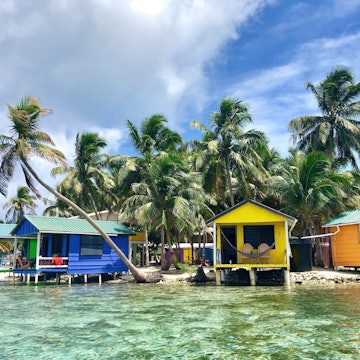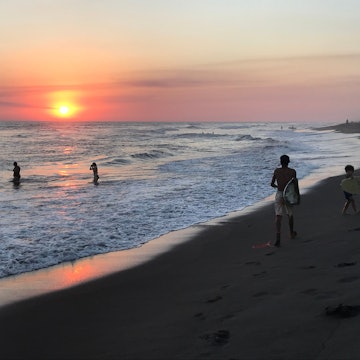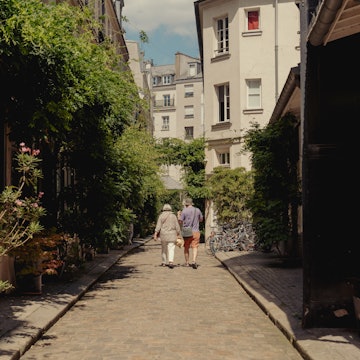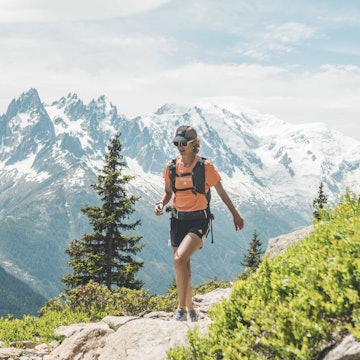
The 10 top things to do in Santa Ana, El Salvador



Parque Libertad in the center of Santa Ana, El Salvador. Oscar Espinosa/Shutterstock
El Salvador’s second city, Santa Ana sits pretty, surrounded by coffee plantations and volcanic peaks to the west of San Salvador. Many travelers choose this relaxed city as a base for exploring the country’s highlights. On easy day trips or overnight excursions, you can climb Volcán de Santa Ana, swim in Lago de Coatepeque, investigate the Maya ruins at Tazumal and Joya de Cerén, or cruise between the laid-back country towns of the Ruta de las Flores.
During the late 19th century, wealth flowing in from the coffee industry transformed Santa Ana from an unremarkable provincial town into El Salvador’s wealthiest city. The city’s grand cathedral was built in 50 years, while its beautiful theater was erected in just two, and coffee money paid for the construction of wide, tree-studded streets lined with colorful, terracotta-tiled houses.
Although coffee is no longer the mega industry it once was, Santa Ana is still an elegant and bustling metropolis, and an increasingly popular stop on the overland route through Central America. You can still get a great cup of Santa Ana coffee at the city’s cafes, and see the beans being grown and processed in the plantations around town.
If that all sounds tempting, here are the best things to do in Santa Ana, El Salvador.

1. Admire Santa Ana’s iconic cathedral
The standout landmark of the city, the Catedral de Santa Ana is a gleaming white, neo-Gothic masterpiece that is illuminated every evening, adding to the atmosphere of the historic center of Santa Ana. Constructed at the height of Santa Ana's coffee boom, the cathedral was completed in 1913. Ornate moldings cover the frontage, while the pillars and high archways inside are painted in slate gray and pink stripes, enhancing the sense of stillness and calm.
A spooky figure of the city's patron saint, Nuestra Señora de Santa Ana, greets you as you enter. She is also the patron saint of women in labor, and the cathedral is a popular place of prayer for expectant mothers. Nuestra Señora de Santa Ana is honored by enthusiastic parades every July.
Planning tip: Other churches worth checking out in Santa Ana include the Iglesia El Calvario and Iglesia El Carmen, built in very different styles.
2. People watch at Parque Libertad
Santa Ana’s main square, Parque Libertad, is a dynamic focal point for the historic center, dominated by the Teatro de Santa Ana, the Catedral de Santa Ana and the city’s grand, Spanish-influenced city hall. Food stands dot the edge of the square, and in the middle is a white statue of the goddess Liberty. Grab some lunch, sit on a bench and people-watch as Santa Ana goes about its daily routine.
Planning tip: On the south side of the square is the Centro De Artes De Occidente Apaculsa, a community-focused cultural center that hosts some interesting art events; pop by and see what’s on.

3. Go to the theater
The elegant, European-style Teatro de Santa Ana was constructed using funds from an export tax on coffee beans, and it still evokes a sense of Belle Époque glamor. The definition of early 20th-century civic showboating, it features stained-glass windows, grand marble staircases and extravagant details inside and out.
In 1933, it was converted into a movie house, but after a major facelift, this graceful structure is now a theater once again. Tickets are inexpensive, so visit the box office to see what is on – expect a mix of plays, stage shows and classical concerts.
Planning tip: For a pre-theater bite, swing by Café Téjas, an inviting garden-facing eatery in a colonial-era house to the south of Parque Libertad.
4. Take a free Santa Ana walking tour
For a local’s view of the city center, check in with the charismatic Hector, an enterprising Santa Ana tour guide who organizes free, English-language walking tours of Santa Ana, starting by the Liberty statue in Parque Libertad. On these informative tours, you’ll head inside the cathedral and get an overview of the history of the city, with anecdotes and little nuggets of information that only a born-and-bred local would know.
The second half of the tour consists of a street-food crawl through the city’s stimulating open-air markets to try eats that go beyond the typical delicacies you may have already tried in El Salvador. Unusual tropical fruits, thick corn-based puddings and tangy fermented beverages are all on the menu.
Planning tip: Tours are free, but tipping is recommended and most tour participants make a contribution.
5. Sample the local coffee
The hills around Santa Ana are dotted with coffee plantations, producing full-flavored Arabica beans. Local coffees are strong, rich and dark, with chocolatey notes and a hint of spice – be sure to linger over a cup while exploring the city.
Good spots to sample the local beans include Cadek Café or Beats Coffee, both just east of the cathedral. For a deeper dive into Santa Ana coffee culture, arrange a visit to one of the local coffee plantations. Just west of the city, the Finca La Esperanza plantation offers tours exploring the production process, with tastings of their house coffees.
Planning tip: Santa Ana coffee goes down well with a traditional Salvadoran breakfast of eggs, beans, bread, fried plantain and queso fresco cheese; most hotels in town can rustle one up.

6. Climb a volcano or three in Parque Nacional Los Volcanes
El Salvador’s volcanoes demand to be climbed, and Santa Ana has three impressive cones that call out to hikers. To the south of the city, the Parque Nacional Los Volcanes (also known as Parque Nacional Cerro Verde) is home to three major volcanoes: Santa Ana (2381m), Izalco (1958m) and Cerro Verde (2030m). Each offers a very different hiking experience through dramatic volcanic scenery.
The popular 8km hike to the top of Volcán de Santa Ana is the most popular ascent, delivering epic panoramas from the summit, as well as views down over a turquoise crater lake with fumes coiling up from its center. Allow about 4 hours for the return hike.
Steeper and more challenging, the perfectly symmetrical cinder cone of Volcán de Izalco was once known as “El Faro del Pacifico” (the “Lighthouse of the Pacific”) due to its regular eruptions. It’s been dormant since 1966, and the 7km climb to the summit passes through a moonscape of clinking cinders (allow 5 hours).
If you fancy an easier hike, passing through cloud forests that are alive with birdlife, set your sights on Cerro Verde, whose name evokes its lush surroundings. The shortest hike here takes only 40 minutes, and you have a good chance of spotting hummingbirds, mockingbirds, cinnamon-bellied flowerpiercers and turquoise-browed motmots.
Planning tip: Parque Nacional Los Volcanes is an hour by bus from Santa Ana; guides for summit hikes can be arranged at the park gates. (Come on the weekend if you plan to climb Izalco.)

7. Swim in Lago de Coatepeque
On the fringes of Parque Nacional Los Volcanes, the ginormous crater lake of Lago de Coatepeque is one of the country’s most picturesque and popular natural attractions. The lake was formed over 72,000 years ago, and its rain-fed waters periodically change color from deep blue to vivid turquoise. Scientists credit either algal blooms or changes to the mineral content and pH levels of the water. This color-changing event last took place in 2019.
The lake is typically accessed from the village of El Congo to the north, around 18km from Santa Ana, and it’s well worth paying the small entrance fee to visit one of the many stilted restaurants that line its shores. While waiting for lunch, you can sunbathe, swim in the lake’s cool waters, or go kayaking, paddleboarding or jet-skiing. Coatepeque is also a hub for freshwater diving, offering the chance to see catfish and submerged forests and lava flows.
Planning tip: From Restaurante Las Palmeras in El Congo, you can take a 40-minute boat cruise around the lake, with a bar serving drinks. Keep an eye out for the president’s private residence on the lakeshore.
8. Dive into pre-Columbian history at Joya de Cerén
About halfway between Santa Ana and San Salvador, UNESCO-listed Joya de Cerén is El Salvador’s answer to Pompeii in Italy. This Mayan farming village was frozen in time by a powerful eruption of the Loma Caldera volcano in around 600 CE. The material that rained down was cool to the touch, and it sealed the village under an airtight blanket, preserving homes, household items, crops and foodstuffs, including chili peppers, beans, cassava, cacao and a whole field of corn.
The site was rediscovered in 1976, and subsequent excavations have uncovered thatch-roofed houses, adobe communal buildings, storehouses and a trove of artifacts, but no human remains, suggesting that the inhabitants of Joya de Cerén had time to flee. Key structures to investigate include the intriguing House of the Shaman and the temazcal, an indigenous sweat lodge used for healing ceremonies and childbirths.
Planning tip: Close to Joya de Cerén, and easily visited on the same trip, the small Maya site of Ruinas de San Andrés features the grass-covered remains of stepped pyramids and plazas.

9. Visit the Maya ruins of Tazumal
About 14km west of Santa Ana, the town of Chalchuapa is dotted with the ruins of ancient Maya settlements. This was an important trade hub for thousands of years thanks to the local abundance of obsidian – the black volcanic glass used by the ancient peoples of Mesoamerica to make razors, blades and arrowheads.
The most visited site is Tazumal, whose name means “the place where the victims were burned.” Inhabited between 400 CE and 1200 CE, the ruins include a 24m-high stepped pyramid, stone altars and a ball court. There’s a good on-site museum, displaying carved figures and pottery found at the site, some of which reveal ancient trade links between Tazumal and communities in Costa Rica and Mexico.
Just north is Casa Blanca, with the modest ruins of a small Maya settlement that was once a center for indigo dyeing. It’s worth strolling over if you visit Tazumal; the site has an indigo workshop where you can learn how to dye your own clothing.
Planning tip: Between Tazumal and Casa Blanca, drop by Laguna Cuzcachapa, a large sulfurous pool reputedly haunted by a spirit selling tamales wrapped with human skin!
10. Take a trip along La Ruta de Las Flores
Santa Ana is a handy hub for exploring the popular Ruta de Las Flores – a 35km route linking some of the most charming country towns in El Salvador. Named for the white coffee flowers that light up the hills every spring, the Ruta de las Flores starts in Ahuachapán, about 35km southwest of Santa Ana, and weaves between the rural townships of Nahuizalco, Juayúa, Salcoatitán, Apaneca and Concepción de Ataco, finishing up at Sonsonate.
Most visitors anchor their explorations in the town of Juayúa, setting for the weekly Feria Gastrónomica food festival, which sees the town center fill up with food stalls serving typical Salvadoran dishes. Local buses provide easy access to the towns along the route; you can stop off at busy markets, local churches, thermal springs, coffee plantations and pretty waterfalls.
Planning tip: From Sonsonate, continue south by bus to Los Cóbanos, known for its golden sandy beaches, where you can arrange dive trips to the largest coral reef system on the Pacific coast of Central America.
This article was adapted from Lonely Planet’s Central America guidebook, published in October 2025.













